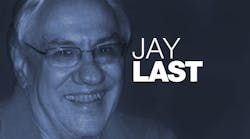Founded in intrigue, Fairchild Semiconductor has a long history of innovation. Indeed, it’s no surprise that a group of men notoriously known as the “Traitorous Eight” would produce some of the most significant technologies of the second half of the twentieth century. Several of these rogue engineers already are members of Electronic Design’s Engineering Hall of Fame. This year, we also induct Jay Last.
The story begins in 1955 as William Shockley, co-inventor of the transistor, founds Shockley Semiconductor Laboratories in Santa Clara Valley with 12 young scientists he calls his “PhD production line.” However, his management style and disenchantment with pure research prompts eight of these engineers to leave the company in 1957.
Gordon Moore, C. Sheldon Roberts, Eugene Kleiner, Robert Noyce, Victor Grinich, Julius Blank, Jean Hoerni, and Jay Last pool $3500 of their own money to develop a method of mass-producing silicon transistors using a double diffusion technique and chemical etching system. Their work catches the eye—and a $1.5 million investment—of Fairchild Camera and Instrument Corp. The rest is history.
Jay Last, who picked up a Brillo carton at a local supermarket and used it to ship the young company’s first order of 100 transistors to IBM, earned a bachelor’s degree in optics from the University of Rochester in 1951 and a PhD in physics from the Massachusetts Institute of Technology in 1956.
During Fairchild’s early years, Last worked on the first commercial silicon planar transistors. He later ran the R&D group that produced the first integrated circuits. He didn’t stay with Fairchild long, though, joining Teledyne in 1961 to form its Amelco division and serve as its vice president of technology until his retirement.
Last’s interests extend beyond engineering. In 1980, he founded the Archaeological Conservancy, which has preserved and protected more than 150 sites in 28 states. He also is president of Hillcrest Press and has written and cowritten a number of books about fine art.
“It wasn’t scary,” Last told Therese Poletti of MarketWatch in May 2011, describing the decision to leave Shockley Semiconductor and form a new company. “When you are in your late twenties, you don’t know enough to be scared. We just did it. We just knew what we had to do and we did it.”
